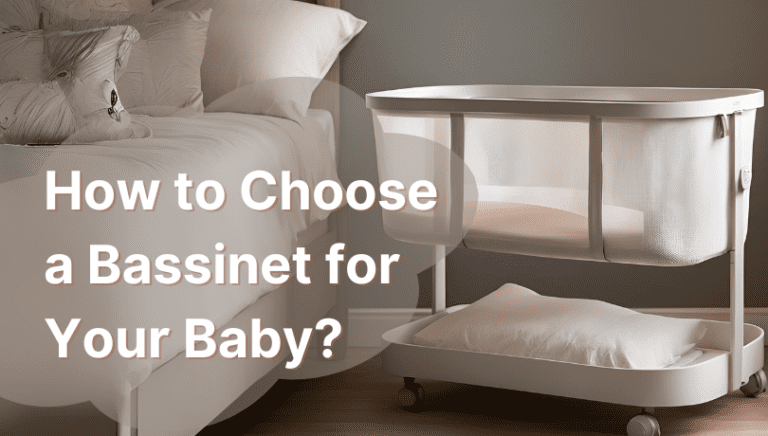What Is A Bassinet: Fundamentals You Need to Know
Back when Terry and I were crib shopping for our first child, we came across bassinets and seriously considered going for a bassinet instead of a crib. While that didn’t work out back then, I did eventually get a bassinet for my third baby.
But before that, I researched what is a bassinet exactly, its size, how long I can use it, the mattresses I’ll need for bassinets, why it was popular, and on and on.
So, in this post, we’ll dive into the fundamentals of bassinets. And I hope you find the answers you’re looking for, dear parents. Let’s get started.
Table of Contents

What Is A Bassinet?
A bassinet is a small-sized bed for infants.
- It has a short bucket-type structure with side rails close to the bassinet’s bottom.
- You’ll notice that they are smaller than cribs. They occupy less space, and you can even keep them near your bed while you sleep.

Also, there is no standard size for a bassinet. This means their mattress sizes also vary.
- For this reason, it helps to buy a mattress with the bassinet for that perfect, snug fit that’s safest for infants. We don’t want unnecessary gaps between the bassinet and its mattress because that can lead to entanglement or SIDS!
What Is A Bassinet Used For? How Do They Help?
We know that babies need their own safe sleeping environment and are not supposed to sleep in the same plush bed as adults. They need to sleep on their own, on a flat, firm surface to prevent dangers like SIDS and accidental suffocation.
- But when you don’t have enough space for a crib or need to have your baby near you for other medical reasons, a bassinet is a safe alternative.
- A fully sealed version of bassinets is also popularly used in hospitals for the ICU.
Terry and I decided to get a bassinet for Fiona, our third baby. It was easy to carry, move, and settle in less spacious rooms.
I also personally love its raised length which makes it a lot more convenient to pick my baby up. So, yes, they’re useful products when you have such space constraints.
Fun Fact: Why Do They Call It A Bassinet?
‘Bassinet’ comes from a French word called “bassin” which means a little basin. And it does look like one.
Also, older bassinets resembled wicker baskets and were called wicker cradles back in the day when they were made of reeds and straws!
Safety Considerations While Using Bassinets
My Fiona loved sleeping in her bassinet, and it was very convenient to have it in the same room as ours. So, if you are considering purchasing one, or you are new to its usage, here are some safety tips that can help you.

1. Sturdy Construction
- Rule numero uno: no wobbly or shaky bassinets will be tolerated! A sturdy build is crucial followed by a firm mattress.
- Check twice if all parts are attached securely, and that there are no sharp edges or protrusions that might harm the baby during sleep.
2. Breathable Materials
- When it comes to choosing a mattress for your bassinet, make sure it is made with breathable materials.
- Never use soft bedding, pillows, or stuffed animals inside the bassinet because those can pose suffocation hazards.
3. Safe Sleep Position
- Babies sleeping on their backs is the only safe sleeping position!
- If they roll over during sleep, make sure to get them on their back again.
4. Monitor Their Temperature
- Your baby needs the room at the right temperature to prevent excessive sweating. So, please ensure your baby is comfy and that the room is not too hot or cold.
- Beyond that, use lightweight and breathable clothing to prevent overheating. And if you live in icy regions, bundle them up to keep them sufficiently warm (but don’t go overboard).
5. Regular Inspection
- I regularly check the bassinet to ensure that the mattress has a snug fit and leaves no gaps. I also check the bassinet’s rails and other fittings for loose screws, wobbliness, and more.
- These regular durability checks help keep your baby safe and ensure that your bassinet stays fit for longer use.
FAQs on Bassinets
1. For How Long Can I Use Bassinets?
Bassinets are usually designed for use from when your baby is a newborn until they turn 4 or 6 months old, depending on the limit that the manufacturer sets.
2. When Should I Transition My Baby From A Bassinet To A Crib?
It’s generally recommended to transition to a crib once your baby starts showing signs of rolling over or reaching the weight or age limits.
Manufacturers usually set the limit at 4 or 6 months. Why?
During this period, babies are not likely to move their tiny hands or feet too much and do not turn or roll. So they can sleep safely in such a small bed without fear of injuries or accidents.
I safely transitioned Fiona in the middle of her 3rd month because she began to crawl a little and move her head. While that was the right time for my baby, the situation might vary for you, so please keep this in mind.
3. Do Bassinets Prevent SIDS?
A bassinet is definitely a safe sleeping space for your baby.
And that’s not me saying this: the American Academy of Pediatricians (AAP) clears cribs, bassinets, portable cribs, and similar products as a safe sleep environment for your baby, preventing chances of SIDS.
So, please ensure your baby sleeps on their back on a firm mattress, and avoid adding any extra padding into your cribs or bassinets, except fitted sheets.
4. Are There Bassinet Weight Limits to Be Aware of?
– Every bassinet comes with a weight limit specified by the manufacturer.
– On average, most bassinets can accommodate a weight of up to 15–20 pounds, which is more than sufficient since they are used for babies only up to 4 or 6 months old.
5. Can Twins Share A Bassinet?
Based on safe sleep guidelines, it’s a strong no.
While it may seem cozy for twins to share a bassinet, it’s safer for each baby to have their own sleep space. However, some specially designed bassinets can accommodate twins side by side, keeping them close but still safe.
Conclusions: What is a Bassinet and Other FAQs
I hope my experience offers you some guidance when choosing the right sleeping space for your baby. Now, you know all about a bassinet, its usage for babies, and how it can be a quick and safe choice.
A bassinet isn’t just a piece of furniture – its handy and sturdy designs help keep your baby by your side, and it’s convenient with its raised design and portability.
Remember, while bassinets provide a convenient and snug sleeping option, it’s crucial to prioritize safety by choosing sturdy constructions, breathable materials, safe sleep positions, monitoring body temperature, and regularly inspecting the bassinet for any wear and tear.






